jacking SUZUKI JIMNY 2022 Owners Manual
[x] Cancel search | Manufacturer: SUZUKI, Model Year: 2022, Model line: JIMNY, Model: SUZUKI JIMNY 2022Pages: 421, PDF Size: 6.35 MB
Page 111 of 421
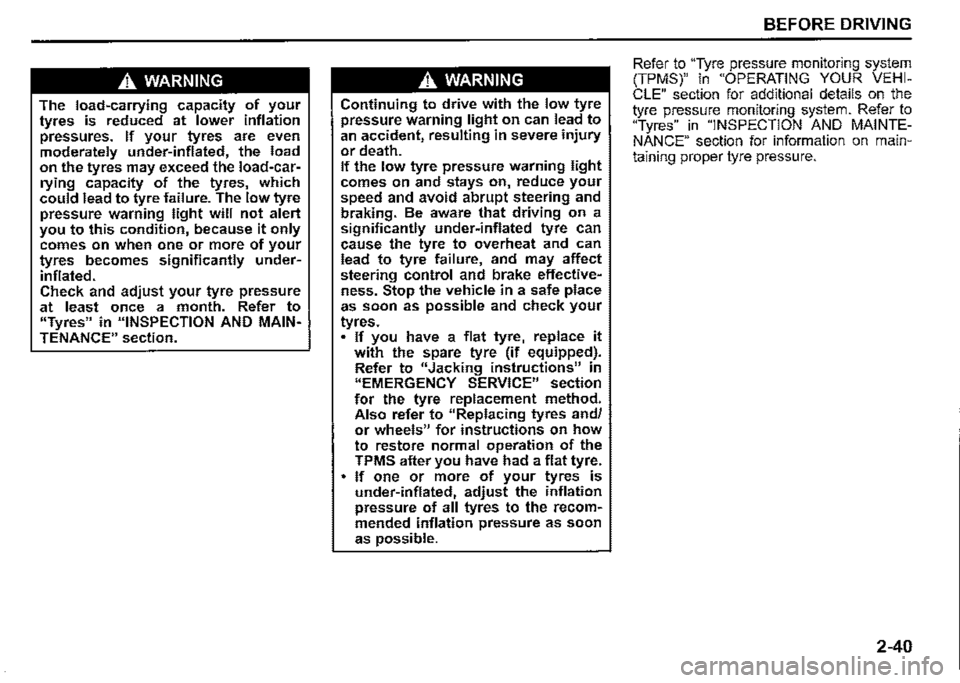
A. WARNING
The load-carrying capacity of your tyres is reduced at lower inflation pressures. If your tyres are even moderately under-inflated, the load on the tyres may exceed the load-carrying capacity of the tyres, which could lead to tyre failure. The low tyre pressure warning light will not alert you to this condition, because it only comes on when one or more of your tyres becomes significantly under
inflated. Check and adjust your tyre pressure at least once a month. Refer to "Tyres" in "INSPECTION AND MAINTENANCE" section.
A. WARNING
Continuing to drive with the low tyre pressure warning light on can lead to an accident, resulting in severe injury or death. If the low tyre pressure warning light comes on and stays on, reduce your speed and avoid abrupt steering and braking. Be aware that driving on a significantly under-inflated tyre can cause the tyre to overheat and can lead to tyre failure, and may affect steering control and brake effectiveness. Stop the vehicle in a safe place as soon as possible and check your
tyres. • If you have a flat tyre, replace it with the spare tyre (if equipped). Refer to "Jacking instructions11 in "EMERGENCY SERVICE" section for the tyre replacement method. Also refer to "Replacing tyres and/ or wheels" for instructions on how to restore normal operation of the TPMS after you have had a flat tyre. If one or more of your tyres is under-inflated, adjust the inflation pressure of all tyres to the recommended inflation pressure as soon as possible.
BEFORE DRIVING
Refer to "Tyre pressure monitoring system (TPMS)" in "OPERATING YOUR VEHICLE" section for additional details on the tyre pressure monitoring system. Refer to "Tyres" in "INSPECTION AND MAINTENANCE" section for information on maintaining proper tyre pressure.
2-40
Page 216 of 421
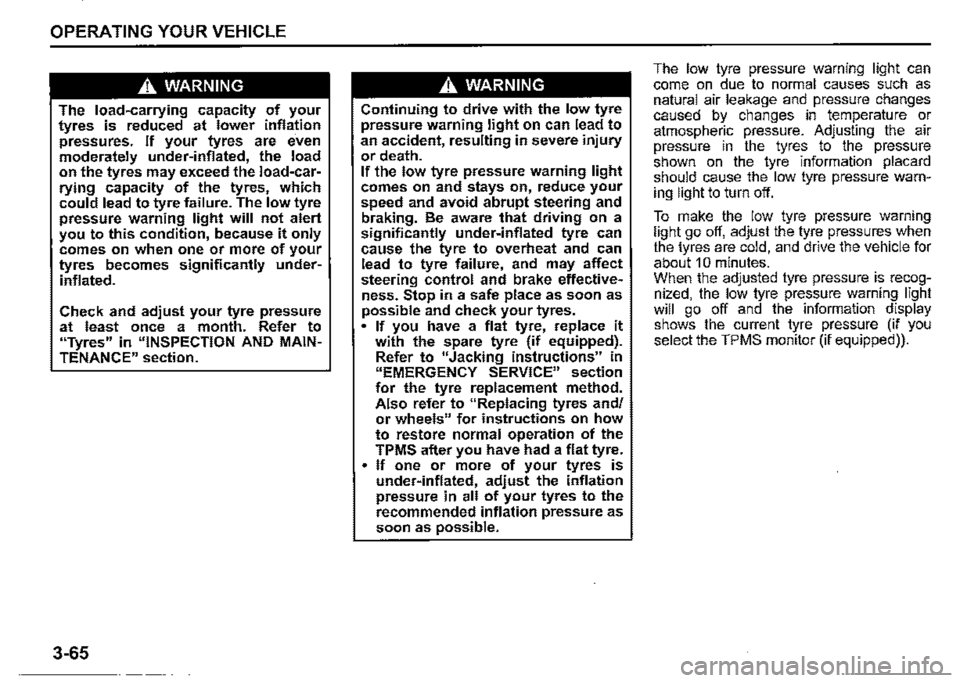
OPERATING YOUR VEHICLE
A WARNING
The load-carrying capacity of your tyres is reduced at lower inflation pressures. If your tyres are even moderately under-inflated, the load on the tyres may exceed the load-carrying capacity of the tyres, which could lead to tyre failure. The low tyre pressure warning light will not alert you to this condition, because it only comes on when one or more of your tyres becomes significantly underinflated.
Check and adjust your tyre pressure at least once a month. Refer to "Tyres" in "INSPECTION AND MAINTENANCE" section.
3-65
A WARNING
Continuing to drive with the low tyre pressure warning light on can lead to an accident, resulting in severe injury or death. If the low tyre pressure warning light comes on and stays on, reduce your speed and avoid abrupt steering and braking. Be aware that driving on a significantly under-inflated tyre can cause the tyre to overheat and can lead to tyre failure, and may affect steering control and brake effectiveness. Stop in a safe place as soon as possible and check your tyres. If you have a flat tyre, replace it with the spare tyre (if equipped). Refer to "Jacking instructions" in "EMERGENCY SERVICE" section for the tyre replacement method. Also refer to "Replacing tyres and/ or wheels" for instructions on how to restore normal operation of the TPMS after you have had a flat tyre. • If one or more of your tyres is under-inflated, adjust the inflation pressure in all of your tyres to the recommended inflation pressure as soon as possible.
The low tyre pressure warning light can come on due to normal causes such as natural air leakage and pressure changes caused by changes in temperature or atmospheric pressure. Adjusting the air pressure in the tyres to the pressure shown on the tyre information placard should cause the low tyre pressure warning light to turn off.
To make the low tyre pressure warning light go off, adjust the tyre pressures when the tyres are cold, and drive the vehicle for about 10 minutes. When the adjusted tyre pressure is recognized, the low tyre pressure warning light will go off and the information display shows the current tyre pressure (if you select the TPMS monitor (if equipped)).
Page 217 of 421
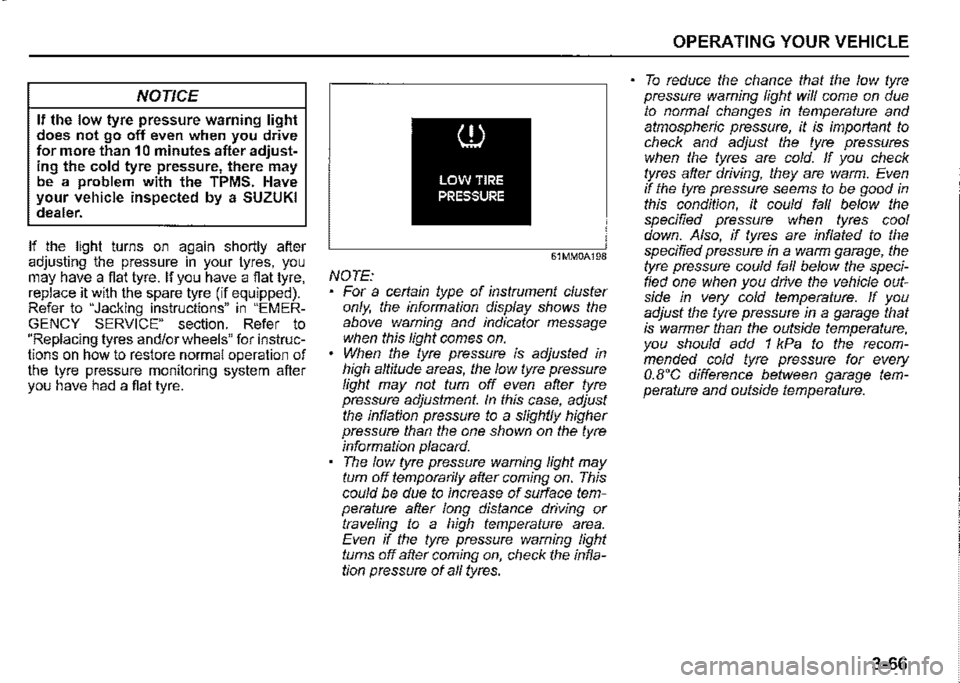
NOTICE
If the low tyre pressure warning light does not go off even when you drive for more than 10 minutes after adjusting the cold tyre pressure, there may be a problem with the TPMS. Have your vehicle inspected by a SUZUKI dealer.
If the light turns on again shortly after adjusting the pressure in your tyres. you may have a flat tyre. If you have a flat tyre, replace it with the spare tyre (if equipped). Refer to "Jacking instructions" in "EMERGENCY SERVICE"" section. Refer to "Replacing tyres and/or wheels" for instructions on how to restore normal operation of the tyre pressure monitoring system after you have had a flat tyre.
61MM0A198
NOTE: For a certain type of instrument cluster only, the information display shows the above warning and indicator message when this light comes on. When the tyre pressure is adjusted in high altitude areas, the low tyre pressure light may not turn off even after tyre pressure adjustment. In this case, adjust the inflation pressure to a slightly higher pressure than the one shown on the tyre informaUon placard. The low tyre pressure warning light may turn off temporarily after coming on. This could be due to increase of surface temperature after long distance driving or traveling to a high temperature area. Even if the tyre pressure warning light turns off after coming on, check the inflation pressure of all tyres.
OPERATING YOUR VEHICLE
To reduce the chance that the low tyre pressure warning light will come on due to normal changes in temperature and atmospheric pressure, it is important to check and adjust the tyre pressures when the tyres are cold. If you check tyres after driving, they are warm. Even if the tyre pressure seems to be good in this condition, it could fall below the specified pressure when tyres cool down. Also, if tyres are inflated to the specified pressure in a warm garage, the tyre pressure could fall below the specified one when you drive the vehicle outside in very cold temperature. If you adjust the tyre pressure in a garage that is warmer than the outside temperature, you should add 1 kPa to the recommended cold tyre pressure for every O.B'C difference between garage temperature and outside temperature.
3-66
Page 356 of 421

INS.PECTION AND MAINTENANCE
4-tyre rotation
65D459
To avoid uneven wear of your tyres and to prolong their life, rotate the tyres as illustrated. Tyres should be rotated every 10000 km (6000 miles). After rotation, adjust front and rear tyre pressures to the specification listed on your vehicle's Tyre Information Label.
6-39
Changing Wheels
78RB07014
To change a wheel, use the following procedure:
1) Remove the jack, tools and spare wheel from the vehicle.
NOTE: How to remove the spare wheel:
78RB07052
1. Remove the center nut (1 ), then remove the spare wheel half cover (2) (if equipped). 2. Remove the wheel nuts of the spare wheel, then remove the spare wheel with both hands.
2) Loosen, but do not remove the wheel nuts. 3) Jack up the vehicle (follow the jacking instructions in the "EMERGENCY SERVICE" section in this manual) 4) Remove the wheel nuts and wheel. 5) Before installing the new wheel, clean any mud or dirt off from the surface of the wheel and hub with a clean cloth. Clean the hub carefully; it may be hot from driving.
Page 377 of 421
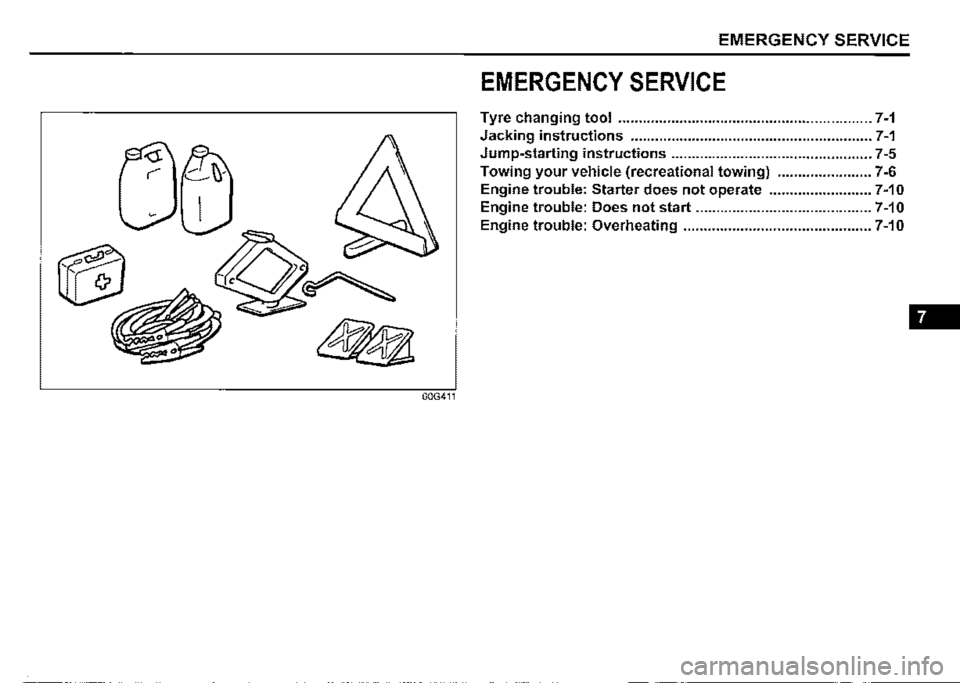
EMERGENCY SERVICE
EMERGENCY SERVICE
Tyre changing tool .............................................................. 7-1
CJ~
Jacking instructions ........................................................... 7-1
Jump-starting instructions ................................................. 7-5
Towing your vehicle (recreational towing) ....................... 7-6
Engine trouble: Starter does not operate ......................... 7-10
Engine trouble: Does not start ........................................... 7-10
Engine trouble: Overheating .............................................. 7-10
·. ~ -
60G411
Page 378 of 421

EMERGENCY SERVICE
Tyre changing tool
0
57
(3) (1) (2)
78RB08001
(1) Jack (2) Jack handle (3) Wheel wrench
The tyre changing tools are stowed in the luggage compartment. Refer to "LUGGAGE COMPARTMENT" in "ILLUSTRATED TABLE OF CONTENTS" section.
7-1
Jacking instructions
75F062
1) Place the vehicle on level, hard ground. 2) Set the parking brake firmly and shift into "P" (Park) if your vehicle has an automatic transmission, or shift int6 "R" (Reverse) if your vehicle has a manual transmission.
A WARNING
Shift into "P" (Park) for an automatic transmission, or into "R" (Reverse) for a manual transmission vehicle when you jack up the vehicle. • Never jack up the vehicle with the transmission in 11N" (Neutral). Otherwise, unstable jack may cause an accident.
3) Turn on the hazard warning switch if your vehicle is near traffic. 4) Block the front and rear of the wheel diagonally opposite of the wheel being lifted. 5) Place the spare wheel near the wheel being lifted as shown in the illustration in case that the jack is slipped.
Page 380 of 421

EMERGENCY SERVICE
Raising vehicle with garage jack
• Apply the garage jack to one of the points indicated below. • Always support the raised vehicle with jack stands (commercially available) at the points indicated below.
7-3
(1)
(1)
..
(1)
(1) Front (2) Rear (3) Jack stand
(5)
78RB08002
(4) Garage jack (5) Jacking point for garage jack
Page 381 of 421
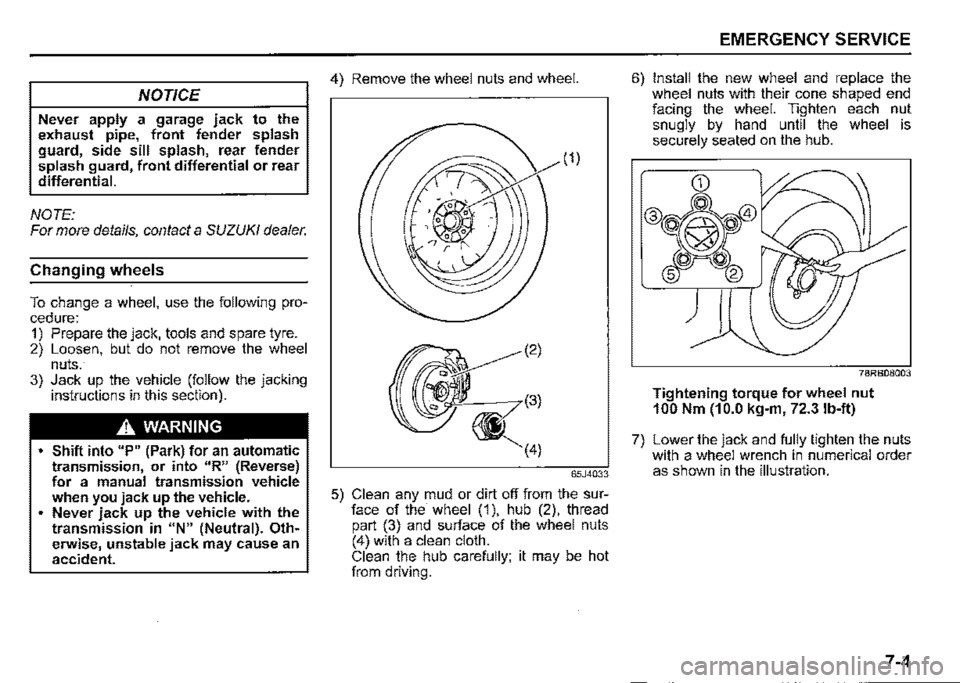
NOTICE
Never apply a garage jack to the exhaust pipe, front fender splash guard, side sill splash, rear fender splash guard, front differential or rear differential.
NOTE: For more details, contact a SUZUKI dealer.
Changing wheels
To change a wheel, use the following pro
cedure: 1) Prepare the jack, tools and spare tyre. 2) Loosen, but do not remove the wheel nuts. 3) Jack up the vehicle (follow the jacking instructions in this section).
A WARNING
Shift into "P" (Park) for an automatic transmission, or into 11R" (Reverse) for a manual transmission vehicle when you jack up the vehicle. Never jack up the vehicle with the transmission in "N" (Neutral). OthR erwise, unstable jack may cause an accident.
4) Remove the wheel nuts and wheel.
65J4033
5) Clean any mud or dirt off from the surface of the wheel (1 ), hub (2), thread part (3) and surface of the wheel nuts (4) with a clean cloth. Clean the hub carefully; it may be hot from driving.
EMERGENCY SERVICE
6) Install the new wheel and replace the wheel nuts with their cone shaped end facing the wheel. Tighten each nut snugly by hand until the wheel is securely seated on the hub.
78RB08003
Tightening torque for wheel nut 100 Nm (10.0 kg-m, 72.3 lb-ft)
7) Lower the jack and fully tighten the nuts with a wheel wrench in numerical order as shown in the illustration.
7-4
Page 413 of 421
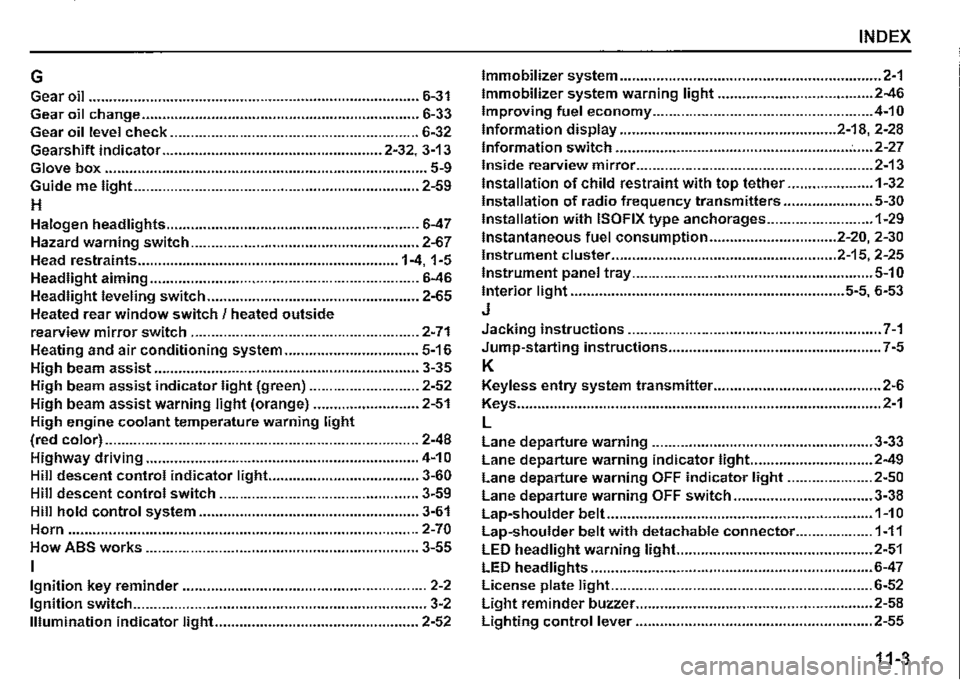
INDEX
G Immobilizer system ................................................................ 2-1
Gear oil ................................................................................. 6-31 Immobilizer system warning light ...................................... 2-46
Gear oil change .................................................................... 6-33 Improving fuel economy ...................................................... 4-10
Gear oil level check ............................................................. 6-32 Information display ..................................................... 2-18, 2-28
Gearshift indicator ...................................................... 2-32, 3-13 Information switch ......................................................... : ..... 2-27
Glove box ............................................................................... 5-9 Inside rearview mirror .......................................................... 2-13
Guide me light ...................................................................... 2-59 Installation of child restraint with top tether ..................... 1-32
H Installation of radio frequency transmitters ...................... 5-30
Halogen headlights .............................................................. 6-47
Hazard warning switch ........................................................ 2-67
Head restraints ................................................................ 1-4, 1-5
Headlight aiming .................................................................. 6-46
Headlight leveling switch .................................................... 2-65
Heated rear window switch / heated outside
Installation with ISOFIX type anchorages .......................... 1-29
Instantaneous fuel consumption ............................... 2-20, 2-30
Instrument cluster ....................................................... 2-15, 2-25
Instrument panel tray ........................................................... 5-10
Interior light ................................................................... 5-5, 6-53
J
rearview mirror switch ........................................................ 2-71 Jacking instructions .............................................................. 7-1
Heating and air conditioning system ................................. 5-16 Jump-starting instructions .................................................... 7-5
High beam assist ................................................................. 3-35 K
High beam assist indicator light (green) ........................... 2-52 Keyless entry system transmitter ......................................... 2-6
High beam assist warning light (orange) .......................... 2-51 Keys ......................................................................................... 2-1
High engine coolant temperature warning light L
(red color) ............................................................................. 2-48 Lane departure warning ...................................................... 3-33 Highway driving ................................................................... 4-1 O Lane departure warning indicator light.. ............................ 2-49
Hill descent control indicator light... .................................. 3-60 Lane departure warning OFF indicator light ..................... 2-50 Hill descent control switch ................................................. 3-59 Lane departure warning OFF switch .................................. 3-38 Hill hold control system ...................................................... 3-61 Lap-shoulder belt ................................................................. 1-1 O Horn ...................................................................................... 2-70 Lap-shoulder belt with detachable connector ................... 1-11 How ABS works ................................................................... 3-55 LED headlight warning light.. .............................................. 2-51
I LED headlights ..................................................................... 6-47
Ignition key reminder ............................................................ 2-2 License plate light ................................................................ 6-52
Ignition switch ........................................................................ 3-2 Light reminder buzzer .......................................................... 2-58
Illumination indicator light.. ................................................ 2-52 Lighting control lever .......................................................... 2-55
11-3